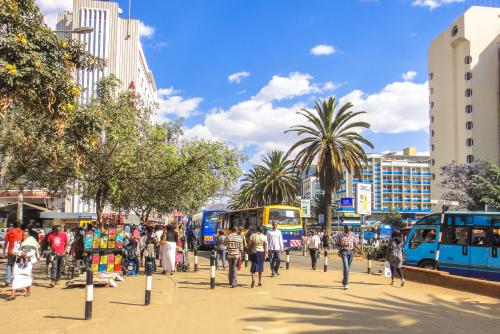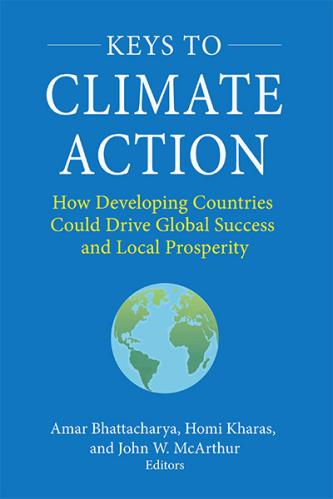This report reflects insights from members of the High-Level Advisory Group on Sustainable and Inclusive Growth, including Brookings Center for Sustainable Development scholars Amar Bhattacharya and Homi Kharas. See the report for the full list of contributors.
Executive summary
A critical time for development and climate action
This decade presents an opportunity to make a breakthrough on both development and climate goals. The past decade’s slowdown in poverty reduction has been accentuated by the recent coronavirus disease (COVID-19) pandemic and the war in Ukraine. This slowdown is further compounded by the deepening climate crisis. A continued slowdown in poverty reduction and shared prosperity would erode global prosperity, as the current historic demographic transition will place virtually all the global population increases over 2020–50 in emerging markets and developing economies (EMDEs) where most of the poverty is concentrated. Collective action must therefore be taken to avert catastrophic climate change and address the slowdown in development gains. Greater awareness worldwide of the climate change challenge offers a unique opportunity for a reset, setting countries on a high-growth green, resilient, and inclusive development (GRID) path that goes hand in hand with environmental goals and social inclusion and addresses the risks to people, the planet, and the economy in an integrated manner tailored to country needs and objectives.
This report makes the case for a big investment push for EMDEs’ sustainable recovery and development, assesses the magnitude and composition of such investment, presents actions needed for an energy transition, looks at the role that innovations and state capacity can play in facilitating GRID, and proposes actions that governments, the private sector, MDBs, the IMF, and donors can undertake to mobilize financing at the large scale needed. The report summarizes the insights derived from the meetings of the High-Level Advisory Group (HLAG) on Sustainable and Inclusive Recovery and Growth, jointly led by Mari Pangestu, Ceyla Pazarbasioglu, and Nicholas Stern, and composed of experts from research institutions, the private sector, and governments, as well as senior World Bank Group and IMF staff members. The work of the HLAG, and thus this report, focuses on EMDEs and delves in greater depth into climate investment and financing, particularly for energy transition, as it is a less researched area. While doing so, it recognizes that policy and investment decisions in high-income countries, which accounted for only 16 percent of the global population in 2019 and yet for 32 percent of total greenhouse gas emissions (World Bank 2023a, 2023b), will be critical to whether the Paris Agreement goals can be reached. It also recognizes that these countries must play a key role in contributing financially to EMDEs’ transition to low-carbon economies.
A big and urgent investment push is needed, but the investments need to be resilient and transformational, not incremental. Investments in human, physical, natural, and social capital must be delivered at unprecedented scale and pace and cut across priority areas that are critical for development and climate. They must be designed to deliver on economic growth, as well as social and environmental needs, and create more sustainable, inclusive, and resilient systems.
Among key systems transformations, energy is critical, with energy access, affordability, and security as key considerations for delivering a just energy transition that meets development and sustainability goals. Energy efficiency and renewable energy must be scaled up massively to meet growing demand in EMDEs so that coal can be phased out as an energy source. The urgent phase out of the existing fleet of coal-fired power stations in high-emitting middle-income countries (MICs) and advanced economies is critical to achieving the Paris Agreement goals in regard to greenhouse gas reduction. A shift to renewables can empower EMDEs to catch up on development: solar and wind power can be expanded across EMDEs more rapidly and more easily than can fossil fuels when network infrastructure is strengthened, energy storage is made available, affordable financing is available, and policies and institutions (including off-takers) are strengthened. For instance, the scaling up of affordable clean energy will lower energy operating costs for EMDEs and facilitate the removal of fuel subsidies, preserving fiscal space for development spending.
Adaptation and resilience measures must complement investments in mitigation to respond to the growing vulnerability to climate change. Boosting adaptation and resilience is an urgent and integral part of development and poverty reduction, especially in low-income countries (LICs) and vulnerable MICs, which have contributed little to past carbon emissions and still account for a very small share of global emissions but will be hardest hit by the impacts of climate change.
Policies, institutions, and platforms for delivering investment
The starting point for the sizable investment push required must be strong country leadership and coordinated action. All countries need well-articulated investment programs, anchored in sound and convincing long-term strategies, to stimulate economic recovery and transformation and deliver on development and climate goals. GRID, climate action, and technology innovation and diffusion will require enhanced coordination across government branches and among government, firms, and citizens, as well as at the international level. There is no global optimal arrangement for institutional frameworks of the type needed; they must be designed in an individually tailored way to fit their contexts. Country ownership is key, as well as greater monitoring and evaluation work on governance to better assess progress.
The realization of needed human, physical, natural, and social capital investments requires an enabling environment with a strong emphasis on development and sustainability. A policy package to address structural weaknesses that constrain action must comprise improvements in regulations and institutions, including measures to correct market failures as well as to reform state-owned enterprises, particularly in the energy sector, to become positive agents of change and help drive the shift to low-carbon alternatives and higher growth. It also entails promoting rapid technological advances and new business models. Public policy has a strong role in providing firms with incentives to redirect innovation toward green technologies. Failure to act promptly will widen the gap between dirty and clean technologies and will make change more expensive. International collaboration and coordination to foster new technologies and set clear direction for the private sector will bring strong gains.
Given the urgency of action, coordination mechanisms to support investment and transition strategies in priority sectors offer a promising way to impart momentum. Countries can benefit from creating mechanisms that help set out clear strategies and investment programs, tackle binding policy impediments, put in place structures for scaling up project preparation, and create replicable and scalable models of financing. It enables countries to ensure that a commensurate scale and mix of financing accompanies their ambitious development and climate commitments. Mixed results of past country platforms have demonstrated that coordination mechanisms must be country-owned and country-led, to ensure trust and legitimacy, and focused on a particular sector or theme, to avoid diluting efforts.
Financing the big investment push
For the investments and structural transformation described in the foregoing to take place, EMDEs will require additional financing in the trillions, not the billions. Though estimates of the magnitude of additional investments necessary to deliver on the Sustainable Development Goals (SDGs) and climate goals vary widely, all are in the trillions. Conservative estimates presented to the HLAG by Bhattacharya et al. (2022) suggest that aggregate additional investment and development spending needs of EMDEs other than China1 are at least on the order of $1.3 trillion per year by 2025 and $3.5 trillion per year by 2030. These figures far exceed existing financing, and they will be magnified further if the interventions are delayed or performed in an inefficient way or if policies are inadequate.
Different sources of financing will be needed given the different types of investment required. The private sector, including institutional investors, will finance bankable investments. Some projects entail elevated risks, high preparation costs or both, requiring de-risking, technical assistance, or grants from concessional resources. Public-goods investments will need to be supported with more highly concessional resources. And social investments and compensations must be financed through public resources, including concessional or grant support, particularly in LICs. Public resources will also be needed to maintain some of the new assets created.
Concessional financing for public goods in MICs needs to be additional and not come at the expense of the huge needs of LICs. Concessional resources for LICs are already under strain and need increasing as these countries deal with the setbacks to poverty reduction and growth prospects resulting from the pandemic and the food and energy price crisis associated with Russia’s invasion of Ukraine.
An integrated debt and financing strategy is needed to overcome constraints to financial access, particularly for climate financing, and mobilize the necessary scale and mix of financing for GRID. The difficult macroeconomic context EMDEs are currently facing constrains access to financing through two channels. First, the deteriorated macroeconomic context and perceived higher risks for mitigation and adaptation investments in those countries relative to advanced economies reduce the attractiveness of climate projects in EMDEs to potential financiers. Second, depleted fiscal space reduces the level of domestic public resources available for climate action, especially as governments face pressure to respond to other pressing development challenges. The HLAG’s work has provided a first attempt at setting such a debt and financing strategy to draw the needed financing from domestic and international sources, both public and private, and on both concessional and nonconcessional terms. The strategy, which focuses particularly on raising climate financing for mitigation and adaptation, is based on three pillars:
1. Public financing
A large share of the needed financing for GRID can be expected to come from domestic sources. For this to happen, however, domestic resource mobilization for public investment and services will need to be improved, and sustainable local capital markets in EMDEs will need to be scaled up and deepened to fund investments in support of GRID. Repurposing of inefficient subsidies in both the food and energy sectors could free up resources; globally, governments spend about $1.2 trillion on subsidies in the agricultural sector and those for fuel.2 However, some of these funds would need to be used to ensure that reforms to the food and energy sectors do not affect vulnerable groups disproportionately. Carbon taxation would raise government revenue while boosting clean industry output and employment. A more supportive international environment that reduces tax evasion and tax optimization would also be helpful.
An immediate challenge is to address debt vulnerabilities and bring down the cost of capital for new investments in EMDEs. Country-specific responses will be required, including new financing to address rollover risk in countries facing short-term liquidity pressures and deep debt reduction for countries facing solvency issues, as well as expanded grant and concessional financing, especially for LICs and climate-vulnerable MICs. Overall, international partners will need to strengthen the implementation of the Group of Twenty Common Framework for Debt Treatment and collaborate on developing stronger mechanisms for resolving debt difficulties.
2. Private sector financing
There is great potential, opportunity, and need for a sizable stepping up in private investment and financing. The private sector can now undertake a growing proportion of sustainable investments in EMDEs, such as those related to the transition to clean energy through commercial-scale solar and wind power. The International Energy Agency (2021a) estimates that about 60 percent of energy transition financing will need to come from private sector.3 To date, however, investments in this area have been small relative to the scale of the need. To open up the pipeline of private capital for the transition, governments need to tackle binding constraints to the investment climate, including the many national barriers to foreign investment and policies that distort competition. Private-sector-led initiatives launched over the past two years to scale up financing for sustainable investments in EMDEs will need to work together proactively and in partnership with countries, multilateral development banks (MDBs), and the International Monetary Fund (IMF) to tackle policy impediments.
Concessional finance to de-risk private investment will also be needed at scale. This is the case for investments in new technologies whose costs are still high but will fall with large-scale adoption and for public-goods investments, which despite clear public benefits (at the national or global level or both) can translate to relatively lower private returns compared to nongreen investments. Greening industrial operations such as cement and steel, for instance, generates a clear public benefit not reflected in private investors’ financial returns. In low-income and fragile nations, macroeconomic risks may outweigh commercial returns available, also requiring concessional financing.
Beyond mobilizing private financing, emphasis must be placed on aligning the financial system with climate and development objectives. Efforts by supervisors and financial regulators are particularly important for ensuring that physical and transition risks do not become realities, helping avert a disorderly transition. Such efforts can strengthen incentives for private financial institutions to align their portfolios with net-zero emissions (while avoiding greenwashing), to shift flows to EMDEs where needs for investment in support of GRID are highest, and to disclose the volume and scope of their contributions in a timely and transparent way.
3. Financing from MDBs, the IMF, and donors
Although MDBs met their collective 2025 financing goals for climate change mitigation and adaptation four years early (Joint Report on Multilateral Development Banks’ Climate Finance) and have significantly stepped up their commitments for financing climate change mitigation and adaptation, the gap between financing and investment needs remains large and growing. Given their comparative advantages, MDBs have significant scope to do more and to evolve so that they can better address global public-goods challenges, building on synergies with the agenda on poverty reduction and other SDGs. First, MDBs will have a key role in helping countries to integrate climate and development and in scaling up investment, but they will need to adjust their tool kits in a variety of ways in order to do so, and they must build on their country focus to support global coordination. The required new approach would imply an expanded use of concessional financing, including grants, and blended financing not only in LICs, but also in MICs, to provide incentives for public-goods investments or investments that entail elevated risks, high preparation costs or both. Second, MDBs should enhance private capital mobilization through an enabling environment and scaling up the use of instruments like guarantees and insurance products. Third, they can explore with shareholders financial innovations to make further use of their balance sheets without affecting their credit ratings so as not to raise the cost of financing for clients. Fourth, they will need greater shareholder financial support to significantly expand their financing—particularly concessional financing—given the gap between the scale of financing needed and current balance sheets. MDBs will need to do “more with more.” The World Bank Group’s (2022c) Evolution Roadmap can help chart its course for responding to the challenges of poverty reduction, shared prosperity, and global challenges.
The IMF will also need to do more to support these efforts. This includes stepped up efforts with the Group of Twenty to improve the Common Framework for Debt Treatment, together with the World Bank. Swift rollout of support through its newly established Resilience and Sustainability Trust will help increase access to financing in many of its members. This trust is supported by the channeling of special drawing rights from countries with strong external positions to help LICs and MICs create an enabling environment for complementary MDB and private sector financing and help address longer-term macro-critical structural challenges, including climate change and pandemic preparedness. Scaled-up focus on carbon taxation and elimination of fossil fuel subsidies as part of Article IV work and increased analytical work in several key areas—policy design to arrest emissions of greenhouse gases and ways to mobilize domestic and foreign private sector financing for climate change mitigation and adaptation as a complement to climate-related policies—will also contribute to needed support.
Donors will also need to significantly step up their efforts to help EMDEs finance their investment requirements. Advanced economies will need to address the shortfall in their commitment to provide and mobilize $100 billion per year to developing countries in financing for climate change mitigation and adaptation and go far beyond it, doubling—at least—mitigation and adaptation financing, including concessional financing, by 2025, compared with their 2019 levels, and steadily increasing them further by 2030, to make the available financing commensurate with what EMDEs need to do. Overall development financing will also need to increase significantly. Greater alignment with countries’ climate and development goals and lower fragmentation in the provision of concessional financing can enhance the effectiveness of donors’ assistance, as can increased use of bilateral guarantees from highly rated countries to de-risk loan exposures and help release capital, as well as greater use by donors of MDBs’ capacity to leverage each dollar of funding to mobilize additional resources—as compared to direct donations and trust funds—to address common public goods like climate change mitigation and action, pandemic preparedness, and response to fragility and conflict.
The urgency, complexity, and transnationality of existing challenges requires all relevant stakeholders to do much more and in a more coordinated manner, working in tandem toward joint agreed-upon goals. This means that governments, donors, MDBs, IMF, and the private sector need to assume agreed upon roles and responsibilities and take more ambitious actions, to jointly reap associated rewards. This in turn implies going beyond comfort zones and working closely together to design innovative solutions befitting a variety of crisis-induced scenarios. EMDEs will need to undertake far-reaching policy reforms; advanced economies must provide quality financing at scale; the private sector will need to step in with investments and technologies; and MDBs, the IMF, and donors will need to update their vision for development financing and delivery. A coordinated effort will help maximize synergies and enhance impact. Despite the challenging conditions, there are tremendous opportunities for growth-enhancing investments, for benefiting from rapid technological advances, and from acting together at a time of fractured geopolitics. Bold actions can unlock the growth story of the twenty-first century: strong, sustainable, resilient, and inclusive.
Box ES.1 summarizes the report’s key recommendations. More detailed actionable recommendations can be found at the end of each subsection in the full report.
Box ES.1. Summary of Recommendations
Strategies and policies
- Policymakers and development partners adopt an effective approach to growth and development, one that eschews the damaging ways of the past, considers interlinkages among people, the planet, and the global economy in policy making, and seizes the opportunities new technological possibilities offer to promote strong, resilient, inclusive, and sustainable growth.
- Countries urgently initiate a major investment push to transform their energy systems, adapt and build resilience to climate change, protect and restore natural capital, promote development, avert the rising cost of climate inaction, and seize the opportunities for growth in the new global green economy.
- Governments create demand for energy transition projects through ambitious long-term strategies underpinned by sound planning. Governments enhance the financial viability of their power utilities, strengthen network infrastructure, set the framework for a just transition away from coal, provide an enabling environment for clean investments, accelerate coal plant retirement, attract the private sector, and compensate losers as needed, particularly the most vulnerable.
- Stakeholders at the global and country levels adjust the policy environment to correct systemic failures. Governments develop long-term investment strategies and undertake reforms to improve the investment climate, deepen financial markets, and tackle political economy, governance and market failures. Carbon pricing, appropriate standards and regulations, or both are key elements of a policy package embodying the needed corrections. Regulators and supervisors develop a supportive international sustainable financial architecture that creates the incentives, tools, and information framework to enable financial institutions to internalize climate-related physical and transition risks.
- Governments promote green technological innovation and diffusion, with support from the development partner community, and provide a clear sense of direction and policy certainty to encourage firms to redirect innovation toward green technologies. While policy approaches to support climate policies and the energy transition may differ across countries, it is important to avoid beggar-thy-neighbor policies, which result in lower trade in green goods and services, lower technological transfers, and an inefficient allocation of resources. Development partners could also explore multicountry mechanisms to support technological breakthroughs in clean technologies for their diffusion to emerging markets and developing economies.
Institutions
- Governments adopt a whole-of-government institutional approach to help address fragmentation of governance systems, develop the required new skills within government, and facilitate the needed coordinated action across government branches and among government, firms, and citizens, as well as at the international level.
- Governments set up or strengthen country-led and country-owned coordination mechanisms to accelerate investments in green, resilient, and inclusive development and the transformation of key systems, bringing together key stakeholders to tackle binding policy constraints and enhancing coordination and the mobilization of the necessary financing.
- Governments adopt second-generation fiscal rules to improve fiscal policy and rebuild fiscal space to support critical investments in a fiscally sustainable way. These new fiscal rules are comprehensive, use a debt anchor, include a small number of operational rules and simple escape clauses, provide enhanced transparency, and place more emphasis on expenditure composition. MDBs, the IMF, and other development partners provide technical assistance as needed.
Integrated finance
- An integrated financing strategy is adopted at the country and global level, employing the complementary strengths of different pools of finance and supported by five actions:
- Donors double—at least—mitigation and adaptation financing, including concessional financing, by 2025, compared with their 2019 levels, and steadily increase them further by 2030; improve access and transparency; align support behind country priorities; and bolster support for multilateral funds. Overall development financing will also need to increase significantly.
- MDBs and the IMF are supported in evolving in the face of multiple crises, increasing their provision of technical expertise and financial assistance, particularly concessional financing, through innovative solutions (including MDB balance sheet optimization) that do not affect their credit ratings, as well as additional financial resources from their shareholders.
- The private sector, MDBs, and the IMF help scale up private sector financing for climate and development through an enhanced partnership between the private sector, MDBs, and the IMF and an active role for the private sector.
- Stakeholders support debt restructuring, including deepening of common understanding of debt-restructuring challenges and enhancing creditor coordination.
- Governments bolster domestic resource mobilization by removing wasteful fuel and agricultural subsidies and redirecting resources and increase fiscal space by deepening tax reforms, modernizing revenue systems, strengthening tax administration, and enhancing the quality of spending.








